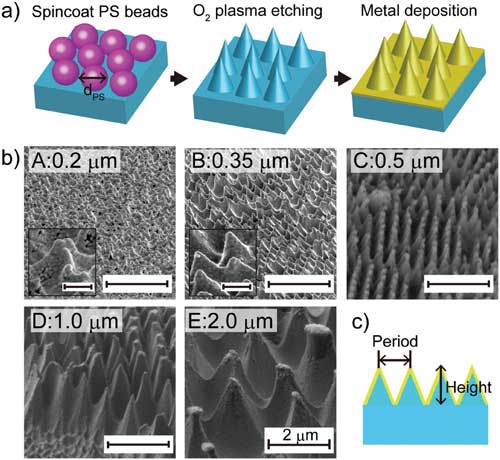| Posted: May 09, 2017 | |
Regulating neuronal behavior with gold nanocone array surfaces(Nanowerk News) In a new paper in Small ("Flexible Gold Nanocone Array Surfaces as a Tool for Regulating Neuronal Behavior"), researchers from Forschungszentrum Jülich in Germany, present flexible gold nanocone arrays as a supporting substrate for culture of neuronal cells with excellent cell viability and possibility for regulating cell activity. |
|
| In their study, the team reports the enhanced neurite outgrowth of rat primary cortical neurons on periodic gold nanocone arrays created on soft and flexible Teflon films. | |
 |
|
| a) Schematic drawings of the fabrication process of the gold nanocone arrays based on colloidal lithography. b) Representative SEM images of the gold nanocone arrays created with 0.2, 0.35, 0.5, 1.0, and 2.0 µm PS beads. The scale bars in the insets indicate 200 nm. c) Illustration of gold nanocone arrays. (© Wiley-VCH Verlag) (click on image to enlarge) | |
| They show that rat cortical neurons cultured on the gold nanocone surfaces exhibit higher survival rate and accelerated neurite outgrowth compared to that on the planar glass substrate. | |
| The morphological changes of neurons were maximized on the nanocone structures fabricated with 1 µm polystyrene beads, with two times longer neurite than that on the glass coverslip in average. | |
| According to the scientists, the detailed observation of the cell/nanocone interface suggests that the gold nanocone arrays provide a surface topography which is similar to the structure of filopodia and dendrite with reasonable contacting area for cell attachment, in addition to the periodicity of the structure to induce the mechanical tension to the neurite, which may be the key factors of the scaffold for the acceleration of the neurite outgrowth. | |
| The researchers conclude that their nanocone array substrates may hold great potentials for the new design of the neuronal interface with 3D nanostructures by following three aspects which are important for the device applications: | |
| First, the structures can be created by a simple and cheap fabrication process without using clean room facilities, and the geometry of nanocones including the pitch and the height is easily controllable. | |
| Second, the Teflon films used as the substrate are flexible and hold antifouling properties. They can be used for enhancing the adhesion of neuronal cells and formation of their networks in the selected area on the device. | |
| Finally, the deposition of gold films allows the substrate to be conductive and to hold unique optical properties supported by surface plasmons, which are crucial for electrophysiological and optical measurements as well as inducing the electric or optical stimuli to the attached cells. |
 By
Michael
Berger
– Michael is author of three books by the Royal Society of Chemistry:
Nano-Society: Pushing the Boundaries of Technology,
Nanotechnology: The Future is Tiny, and
Nanoengineering: The Skills and Tools Making Technology Invisible
Copyright ©
Nanowerk LLC
By
Michael
Berger
– Michael is author of three books by the Royal Society of Chemistry:
Nano-Society: Pushing the Boundaries of Technology,
Nanotechnology: The Future is Tiny, and
Nanoengineering: The Skills and Tools Making Technology Invisible
Copyright ©
Nanowerk LLC
|
|
|
Subscribe to a free copy of one of our daily Nanowerk Newsletter Email Digests with a compilation of all of the day's news. |
